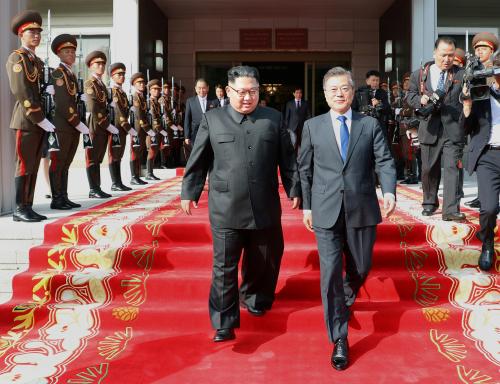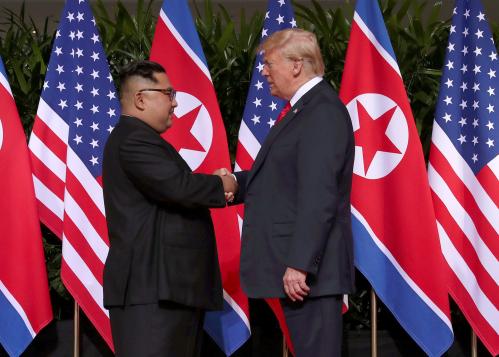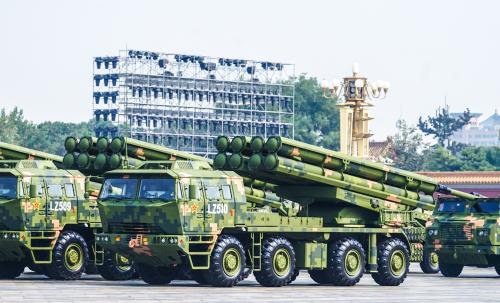The following is the text of a speech that Robert Einhorn delivered at the Sasakawa Peace Foundation in Tokyo on October 2, 2018
There’s a common thread that runs through the Trump administration’s approaches to North Korea and Iran. It’s a lack of realism about what can be achieved with available leverage.
In the case of Iran, Secretary of State Mike Pompeo outlined 12 ambitious requirements for a “new deal” with the Iranians. His demands include a complete halt to uranium enrichment, unqualified access of International Atomic Energy Agency inspectors anywhere in the country, a ban on the development or flight-testing of nuclear-capable missiles, the end of Iranian support for Hezbollah and other regional proxies, the withdrawal from Syria of all forces under Iranian command, and the cessation of Tehran’s threatening behavior toward U.S. regional partners.
The administration believes that, by withdrawing from the Iran nuclear deal and re-imposing sanctions that were suspended under the deal, it could compel Iran to accept U.S. demands—or face the prospect of regime collapse.
To be sure, the re-imposition of U.S. sanctions—especially the oil and financial sanctions that will take effect in November—will put great pressure on Iran. Most international banks and businesses will disengage from Iran. Importers of Iranian crude oil will reduce their purchases and deprive Iran of needed revenue. These pressures will exacerbate Iran’s already-precarious economic situation.
But the pressures won’t be strong enough to force the Islamic Republic’s capitulation or collapse.
In part, that’s because the new sanctions will not be as powerful as the sanctions imposed in the 2012-2013 period. In the earlier period, the international community was united in pressing Iran to accept limits on its nuclear program. Today, it is deeply divided, with many countries (including U.S. European allies) blaming the United States for the current situation and seeking to preserve trade and investments with Iran, not isolate Iran economically.
In addition, today’s pressures will not be strong enough because U.S. demands go far beyond what any Iranian government would be willing or able to accept. Most Iranians resent the U.S. unilateral withdrawal from a multilateral deal they regard as equitable and working well. They would strongly oppose making major new concessions on core Iranian interests in the face of what they see as U.S. bullying. Iranian hardliners who in 2015 opposed the nuclear deal as giving away too much would fiercely attack any Iranian government that surrendered to U.S. demands.
So the Trump administration is trying to achieve much more than the Obama administration achieved in 2015—but with significantly less leverage. That is not a recipe for success. Unless the administration gets realistic about what is achievable, Iran will sooner or later leave the nuclear deal and start building up its nuclear capabilities.
The North Korea challenge
The administration also needs to get realistic on North Korea. The administration’s goal is the complete and verifiable denuclearization of North Korea. And it wants to achieve that goal by early 2021. The administration is willing to offer economic and security rewards to the North, but only after denuclearization is well underway. To pressure the DPRK to denuclearize, it plans to maintain its maximum pressure campaign until denuclearization is virtually completed.
Kim Jong-un has a different approach in mind. In the Singapore joint statement, he committed to “work toward complete denuclearization.” But he favors a step-by-step process in which North Korean steps toward denuclearization are matched at every stage by U.S. steps toward building a peace regime on the Korean Peninsula, improving U.S.-DPRK relations, and removing U.S. sanctions.
Reportedly, the current U.S.-DPRK impasse is over sequencing. Pyongyang insists that the United States first join in a declaration that would bring an end to the Korean War. Washington insists that North Korea first make a declaration revealing the numbers and locations of its nuclear weapons, fissile materials, ballistic missiles, and production facilities.
I believe the impasse is not just over sequencing. More fundamentally, it is over whether North Korea is really willing to give up its nuclear and missile capabilities completely.
I don’t believe Kim Jong Un has any intention of completely giving up his nuclear deterrent, what North Koreans call their “mighty sword.” Most experts on North Korea share this assessment.
I think Kim is sincere about giving priority now to economic development. But he only believes he can turn to economic development because North Korea has ensured its security with thermonuclear weapons and ICBMs.
I believe Kim is also sincere about improving relations between North and South Korea. He knows that only South Korea has both the capacity and the motivation to provide the resources to enable the North to realize its economic goals.
For Kim, it is not economic development or a nuclear deterrent. It is economic development and a nuclear deterrent.
In order to obtain the economic assistance, security assurances, and international standing he desires, Kim Jong-un, in my view, is prepared to limit and perhaps even reduce his nuclear and missile capabilities.
The steps the North has taken to date should be seen in that light. It has suspended nuclear weapons tests and missile flight tests, destroyed the entrances to its nuclear test site, pledged to dismantle a rocket engine test site and launch pad under observation by international experts, and said it would permanently dismantle its Yongbyon nuclear complex if the United States takes corresponding steps.
All of these steps are worthwhile and shouldn’t be dismissed as meaningless gestures. But they certainly provide no indication that North Korea is serious about complete denuclearization.
President Trump hopes his maximum pressure campaign will eventually compel Kim Jong-un to accept complete and rapid denuclearization. In 2017, worldwide alarm with North Korea’s nuclear and missile advances enabled the United States to gain support for significantly strengthened U.N. Security Council sanctions. Crucially, China began enforcing those sanctions more conscientiously than ever before. By the end of 2017, the sanctions really began to bite.
But since then, sanctions momentum has largely been reversed—a casualty of Kim Jong-un’s charm offensive, summit diplomacy, Trump’s premature declaration that North Korea is no longer a nuclear threat, inter-Korean détente, U.S.-Chinese trade frictions, and other factors.
There are reports that Russian and Chinese entities are helping North Korea circumvent existing sanctions, including with illicit ship-to-ship transfers of petroleum products. In addition, Moscow and Beijing are openly proposing an easing of existing Security Council sanctions. And North and South Korea are planning economic projects that would require exceptions to, or a relaxation of, the sanctions regime. President Moon Jae-in clearly does not favor tightening the screws on the North.
So, with sanctions pressures eroding, any prospect of forcing North Korea to accept complete and rapid denuclearization—always a huge challenge—has become exceedingly remote.
A second Trump-Kim summit meeting is now being planned. In the run-up to the summit, Secretary Pompeo and other senior Americans will meet with their North Korean counterparts in the hope of ending the current impasse. It is possible they will produce joint statements that, like the Singapore summit statement, would be portrayed as progress but would paper over key differences. They may even agree on some concrete, reciprocal steps that would constitute real, if modest, forward movement and keep the process on track, at least for the time being.
But sooner or later, it will become clear to the Trump administration that North Korea will not accept complete denuclearization or will accept it only if it is linked to conditions that the United States and its East Asian allies would find unacceptable, such as the end of U.S. security alliances or the withdrawal of U.S. forces from the region.
Once it is recognized that complete denuclearization is not in the cards, the United States will face a choice between two not very attractive options. The first is an agreement that would require North Korea to limit and even reduce its nuclear and missile capabilities but would stop short of committing it to eliminate those capabilities in an agreed timeframe. The second involves abandoning negotiations and pursuing a strategy of pressure, deterrence, and containment.
The first option, at a minimum, would ban the testing of nuclear weapons and certain categories of missiles and require the declaration and verified suspension of all fissile material production activities anywhere in North Korea, including at currently undeclared sites. It might also go beyond a cap to require a reduction in existing nuclear weapons and missiles and the decommissioning of key nuclear and missile production facilities.
The first option would contain a commitment to continue negotiations toward the goal of complete denuclearization, but it would not set a deadline for reaching that goal. It would leave open, for subsequent agreement, the question of how and when the process would be completed.
The second option would be based on the assumption that an agreement with an untrustworthy DPRK regime, especially an agreement that put off denuclearization to a distant and uncertain future, would not serve U.S. and allied interests. The United States and its allies would discontinue negotiations and embark on a long-term strategy designed to squeeze the North Korean regime, deter its aggressive behavior, and eventually bring about its fundamental transformation or collapse.
The second option would avoid the uncertainties and political risks of an agreement that did not eliminate North Korea’s nuclear deterrent altogether. But it has significant disadvantages. In the absence of negotiated limits, Pyongyang would be free to advance its nuclear and missile programs, both quantitatively and qualitatively, well into the future. Moreover, in light of the high expectations surrounding recent high-level diplomacy, it would be hard to mobilize strong support for a renewed pressure campaign, including by China, Russia, and even South Korea. And while regime change may be the path most likely to result in complete denuclearization, the ability to engineer regime change from outside North Korea is very limited.
The first option also has serious disadvantages and would be controversial. Critics would argue that, despite the commitment to continue negotiations toward complete denuclearization, a partial agreement would effectively concede North Korea’s status as a de facto nuclear-armed state. They would warn that a partial deal would result in the relaxation of international pressures needed to push North Korea further down the path toward denuclearization. And they would object to giving Pyongyang rewards for an agreement that stops short of complete denuclearization.
But the first option could also bring significant benefits. It would impede further advances in DPRK nuclear and missile capabilities, making it easier and less costly for U.S. and allied defense planners to develop and deploy effective responses to the North Korean threat, including more capable missile defenses. It would command broad international support, including from China, Russia, and South Korea. The extensive monitoring arrangements it would require would provide a greater window into DPRK intentions and capabilities than we would otherwise have. And it would open channels of communication that could be used to reduce tensions and avoid dangerous miscalculations.
The choice between the two options is not easy. Neither option is very attractive. I favor the first option, but I recognize that many in the Trump administration—and perhaps also in the Japanese government—will take a different view.
So far, virtually all governments have avoided the choice between these two options. Instead, they have continued to reaffirm their allegiance to an agreement providing for complete denuclearization in a definite timeframe. Such an agreement, of course, would be the ideal solution. The problem, as many governments already recognize, is that complete denuclearization is unrealistic, at least in the foreseeable future.
Sooner or later, it will become clear that complete denuclearization is not going to happen. At that point, the United States, Japan, and other interested governments will have to face up to the choice between the only options that are available. It is not too soon to start thinking realistically about that choice.









Commentary
Let’s get realistic on North Korea and Iran
October 5, 2018